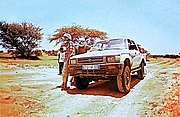Learn more about toyota hilux v6 engine.
Hilux V6 - Raptor Supercharger 4 psi - 1GRFE engine
Toyota Hilux 2006 - Automatic - 4.0 V6 Xtra cab with 4psi boost1GRFE engine.
-
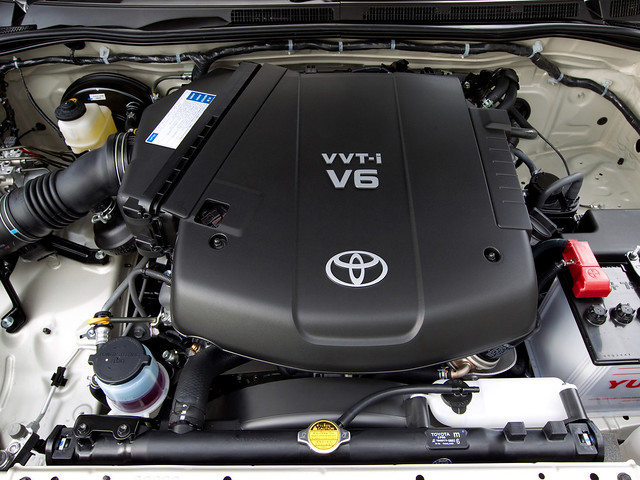
Toyota Hilux SR5 au-spec
2011 Toyota HiLux V6 petrol engine
Photo by EmilasLex on Flickr
-

Camry V6 collection mission
So, last weekend I sold this to someone who wanted its V6 engine for an MR2 conversion. I suspected that was the way it would go when I put it up for sale. When it transpired he was only as far as Northampton and the...
Photo by Spottedlaurel on Flickr
-

1984 Toyota Hilux V6
Fitted with a 3 litre ford V6 engine
Photo by Hannes.v.R on Flickr
-

1984 Toyota Hilux V6
Fitted with a 3 litre ford V6 engine
Photo by Hannes.v.R on Flickr
-

Fuel_Filter_Setup
This is how I setup my fuel delivery to my 1KZ-TE engine swap. I added a filter from an early 80's toyota pickup. Where the rubber hose is, used to be where the stock fuel pump for the V6 engine was. I had to...
Photo by BioRunner on Flickr
-
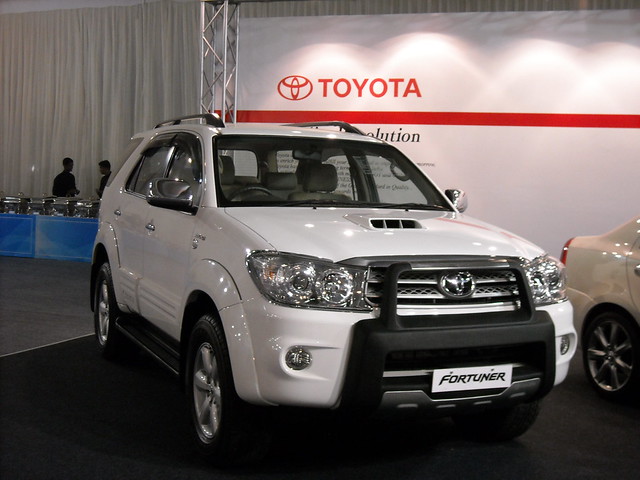
Global Investors Meet - Toyota
The Government of Karnataka conducted a Global Investors Meet (GIM) on June 3 & 4, 2010 at Bangalore to show case the resources available in Karnataka, achievements and to invite further investments in the State....
Photo by Velachery Balu on Flickr
-
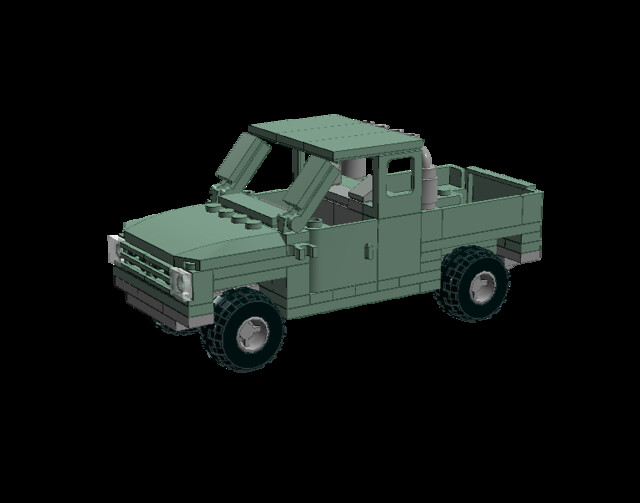
Pickup
Army green military pickup. I designed it to be Toyota Hilux Extra Cab, but i made V6 engine in it.
Photo by Hoffren on Flickr
-
Facelifted Toyota Prado arrives in NZ with new engine
08/26/15, via Stuff.co.nz
Prado has had its 3.0-litre 1KD-FTV turbocharged diesel engine replaced by a newly-developed 2.8-litre 1GD-FTV unit - the same engine as will be aboard the new Hilux ute that is due for New Zealand launch in November. "There's an old saying about
-
TOTD: Would You Buy a Ford Ranger if it Came to the U.S.?
08/26/15, via Motor Trend
Reports surfaced today that Ford is seriously looking to revive the long-lost Ranger in the U.S. In fact, Ford is apparently trying to put the global pickup into production at its Michigan Assembly Plant, possibly by 2018. But we want to know: If Ford
-
Cavernous Volvo XC90 leads suburban SUV pack
08/25/15, via BDlive
The car sales statistics released monthly by the National Association of Automobile Manufacturers of SA show that the usual frontrunners are various incarnations of the Volkswagen Polo and Polo Vivo; the Ford Ranger and the Toyota Hilux; and the Toyota
-
Why Don't We Get Small Trucks in America?
08/21/15, via Jalopnik
Other countries get extremely successful, and supposedly extremely awesome trucks like the Toyota Hilux or the newer Ford Ranger I just saw on Jalop. It seems like those kinds of trucks would do pretty well here. Why don't we get them? Do the So
-
How The Toyota Tacoma Grew From Japanese Oddity To All American
08/07/15, via Yahoo Autos (blog)
And most Toyota trucks have been beasts of burden; wheelbarrows with four wheels and four-cylinder engines. Toyota's new 1969 HiLux wasn't exotic in any way, but it was smaller than the Stout, significantly more refined and much more comfortable.
-
2016 Toyota Tacoma first drive
08/17/15, via Autoweek
The coarse 236 hp 4.0-liter V6 is gone; a techy new 3.5-liter V6 replaces it, delivering 278 hp through both port and direct injection. This engine also packs Toyota's most advanced variable valve timing systems, VVT-iW, allowing the V6 to at times run
-
RGM Hilux still going strong
07/29/15, via Citizen
RGMotorsport's solution comes in the form of an engine upgrade to compensate and in this instance the Toyota V6 gets fitted with a supercharger kit – a conversion which has been tried and tested. In fact, across Hilux, Fortuner, Prado and FJ Cruiser,
-
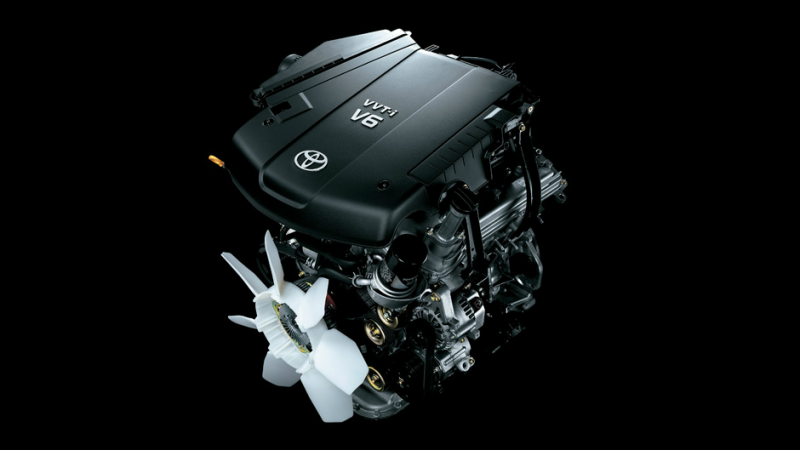 Litre V6 Engine with VVT-iImage by toyota.com.au
Litre V6 Engine with VVT-iImage by toyota.com.au -
 toyota-hilux-vigo-sr5-v6-lpg-conversions-engine-complete
toyota-hilux-vigo-sr5-v6-lpg-conversions-engine-complete -
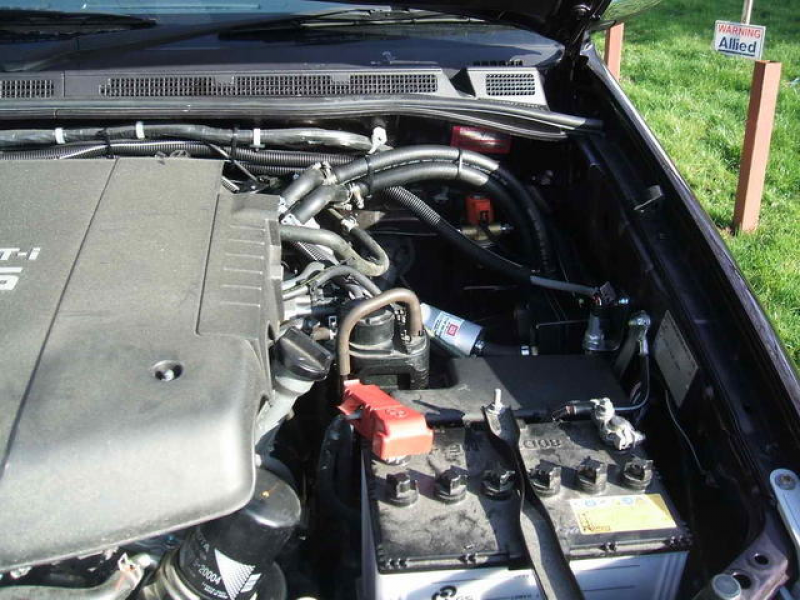 toyota-hilux-vigo-sr5-v6-lpg-conversions-engine-detail
toyota-hilux-vigo-sr5-v6-lpg-conversions-engine-detail -
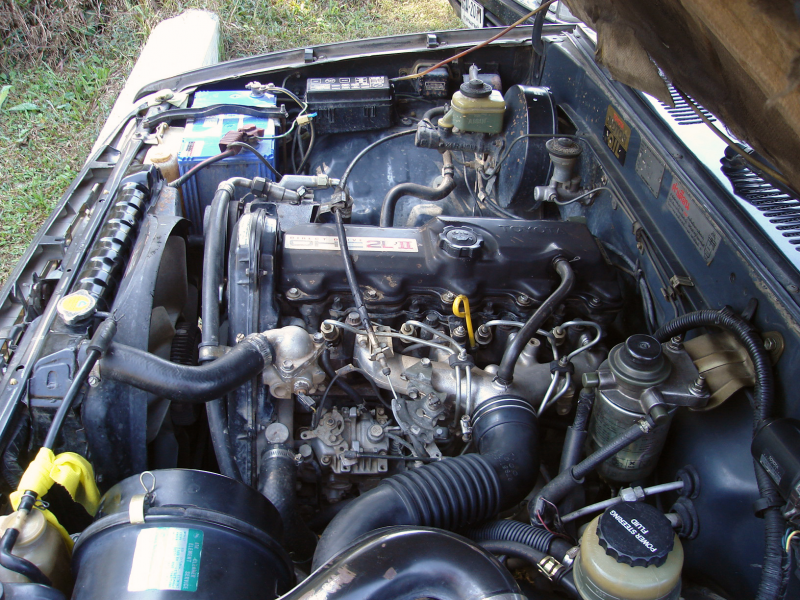 Description Toyota Hilux engine 2.jpgImage by en.wikipedia.org
Description Toyota Hilux engine 2.jpgImage by en.wikipedia.org -
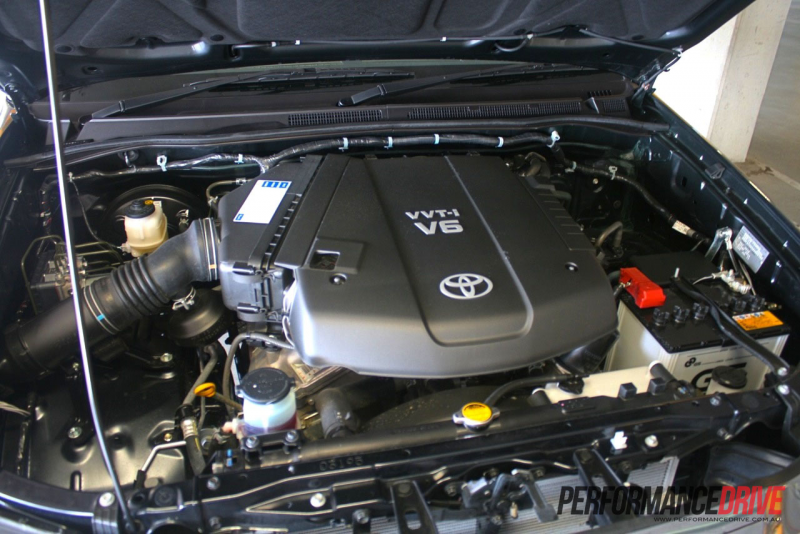 2015 Toyota Hilux – EngineImage by www.2015bestcar.com
2015 Toyota Hilux – EngineImage by www.2015bestcar.com -
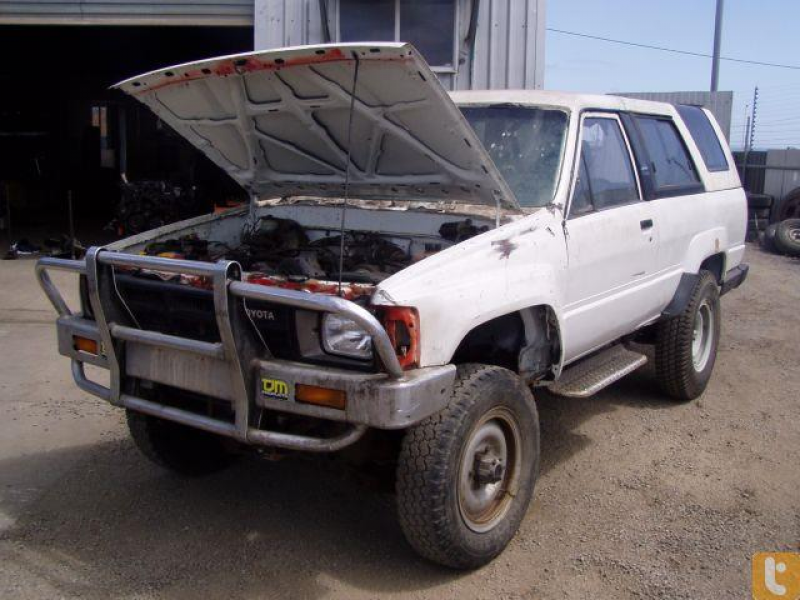 TOYOTA HILUX 4 runner 86 RN YN63 V6 engine automatic - $1,650.00Image by www.autosalvagerecyclers.com.au
TOYOTA HILUX 4 runner 86 RN YN63 V6 engine automatic - $1,650.00Image by www.autosalvagerecyclers.com.au -
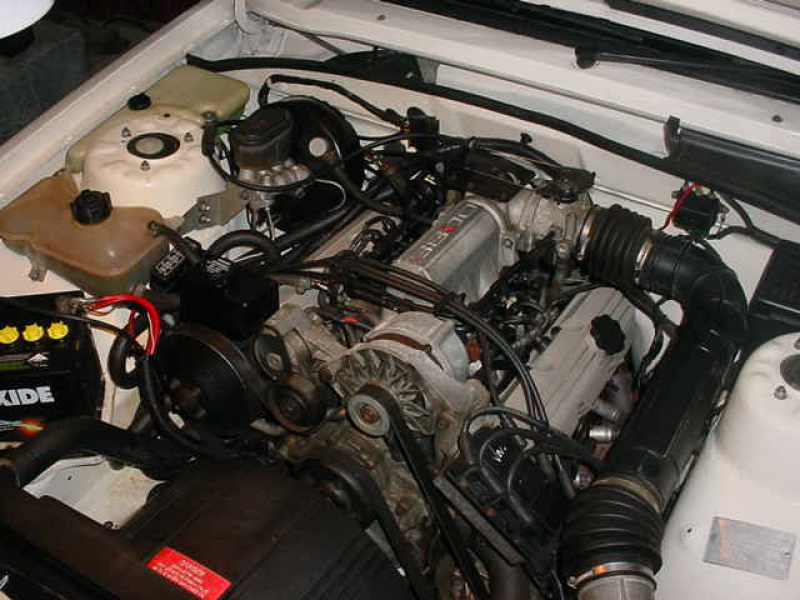 My VK V6 Conversion finished!-engine.jpgImage by forums.justcommodores.com.au
My VK V6 Conversion finished!-engine.jpgImage by forums.justcommodores.com.au -
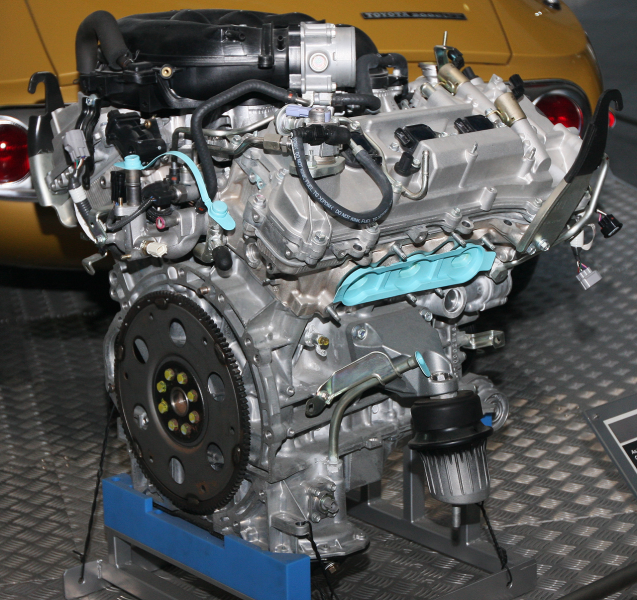 Description 2004 Toyota 4GR-FSE Type engine rear.jpgImage by commons.wikimedia.org
Description 2004 Toyota 4GR-FSE Type engine rear.jpgImage by commons.wikimedia.org -
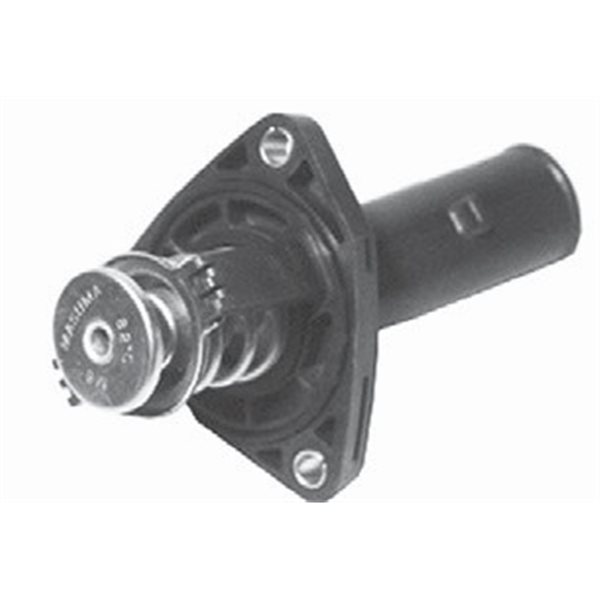 Toyota Hilux 4.0 V6 Thermostat ( Engine Code -1GR-FE ) 06 onImage by www.onlinecarparts.co.za
Toyota Hilux 4.0 V6 Thermostat ( Engine Code -1GR-FE ) 06 onImage by www.onlinecarparts.co.za
-
Considered Mercedes-Benz?
View New Models & Special Offers. See What Drives Us – Official Site.
-
Hi-Lux
Up to 50% Off Top Brands Free 2-Day Shipping w/ Amazon Prime
-
Japanese Engines
Used Japanese engines Imported directly from Japan. Low Prices
-
Toyota V6 Engines
40 Toyota V6 Engines Find our Lowest Possible Price!
-
Ask a Mechanic Now
A Mechanic Will Answer in Minutes! A Question is Answered Every 9 Sec.
-
V6 Engines
Explore V6 Engines. Get Answers Now on Ask.com.
-
Low Mile Japanese Engines
Free 1 Yr Warranty BBB A+ Rating Affordable Quality for over 30 Yrs
-
Toyota Hilux Engines
Find Toyota Hilux Engines. Price Comparisons & Product Reviews
-
Toyota Engines
Compare Toyota Engines August 2015 Bargains - Buy Now
-
Engine For Sale
Quality Used OEM Parts Lowest Prices. Buy Now!
-
Hilux 4WD - V6 Conversation
COMMODORE V6 3.8LTR EFI
INTO
HILUX 4X4 / 4 RUNNER.
V6 Conversions offer conversion kits to allow the fitting of Commodore V6 EFI engines to Hilux 4WD petrol or diesel vehicles. You can use the standard 5 speed transmission or alternatively the Commodore 700R-4 or 4L60-E 4 speed automatic transmission.
CONVERSION INFORMATION.
The Commodore V6 engine can be adapted to the Hilux 4WD petrol or diesel. Using 5 speed gearbox. The bell housing has been designed to space the engine away from the firewall in order to clear the V6 throttle body located at the rear of the intake manifold. There are no firewall modifications, re positioning of the transmission or drive shaft modifications required.
The clutch is coupled to the gearbox by a special gearbox input extension shaft. It has the GM spigot diameter with external spline on the engine end and Toyota spigot diameter with internal spline on the gearbox end.
The bell housing allows the standard V6 GM clutch pressure plate with a V8 clutch disc to be used on the V6 flywheel. The V8 clutch disc provides less clutch shudder due to the clutch plate having stronger centre springs.
The Hilux diesel 4 cylinder slave cylinder must be used. It will need to be re-sleeved to 11/16” bore. This is required to give sufficient throw for correct clutch operation.
AUTOMATIC TRANSMISSION TO TRANSFER CASE.
V6 Conversions have available transfer case adaptor kits to fit GM Turbo 700R-4 and 4L60-E automatic transmissions to Hilux 4WD gear driven transfer cases & chain driven transfer cases. The transfer case adaptor housing replaces the automatic transmission extension housing. The adaptor housing then fits to the transfer case using the original Toyota bolts. The housing has mounting provision for the Hilux 4WD hi-low lever.
The automatic transmission will need to be disassembled. The main output shaft is removed and replaced with one supplied in the adaptor kit. This output shaft has a new spline to connect to the Hilux 4WD coupling sleeve found on the main shaft of the 4 or 5 speed gearbox.
The left hand chassis mounting uses the standard GM engine bracket and mounting rubber. This design allows the use of the standard GM air-conditioning compressor if required. The new bracket is welded to the chassis.
The right engine mounting bracket bolts to the Commodore V6 engine block and fits to the Hilux 4WD diesel 4 cylinder mounting rubber and chassis post.
The 3 core diesel radiator is large enough to keep the Commodore engine cool. The 2 row petrol radiator is too small and must be replaced.
The Commodore engine does not have an engine driven cooling fan, an electric fan must be used for the conversion.
Commodore VR, VS, VT and VY engine management computers require a stream of data to be sent to them from the body control module prior to starting the engine. This is part of the vehicles anti-theft system, unfortunately the system can not be used in the 4WD application. The stream of data required by the ECM is a special one off code, this makes it very hard to duplicate. Fortunately the input to the ECM can be switched off by changing the program information in the memcal. V6 Conversions can supply memcals on an exchange basis.
TACHO INTERFACE KIT.
The tachometer interface will make operative the diesel 4 cylinder tachometer by converting the pulses received from the V6 DFI module.
KIT CONTENTS.
* bell housing adaptor or transfer case adaptor
* engine mount kit
* speedo kit
* wiring kit
* fitting instructions
* sump & oil pickup ( if Independent )
Kit price - $2,225.00 Leaf Spring ( GST inclusive )
or - $2,625.00 Independent ( GST inclusive )
Optional Extra’s
* Tacho interface - $150.00
* EFI fuel pump - $240.00
* 16” thermo fan - $200.00
* Idler kit VN - VR - $150.00
* “ “ VS - VT - $175.00 this is to be used if not running power steering.
* Body Control Simulator VR-VS - $325.00
* “ “ “ VT-VX - $425.00
* VT - VX wiring looms are $25.00 extra on normal wiring looms.
If you have any further questions not covered in this information sheet please contact us for further information.
?
?

-
Toyota Hilux - Wikipedia, the free encyclopedia
Toyota Hilux
_SR5_4-door_utility_(2011-11-18).jpg/280px-2005-2008_Toyota_Hilux_(GGN15R)_SR5_4-door_utility_(2011-11-18).jpg) Overview
Manufacturer
Toyota Motor CorporationToyota Motor Thailand Co.,Ltd.
Also called
Toyota Pickup (US)
Production
March 1968–present
Body and chassis
Platform
Toyota "N"
Chronology
Predecessor
Toyopet Light (Stout)Hino/Toyota Briska[1]
Successor
Toyota Tacoma (Japan and North America)
Overview
Manufacturer
Toyota Motor CorporationToyota Motor Thailand Co.,Ltd.
Also called
Toyota Pickup (US)
Production
March 1968–present
Body and chassis
Platform
Toyota "N"
Chronology
Predecessor
Toyopet Light (Stout)Hino/Toyota Briska[1]
Successor
Toyota Tacoma (Japan and North America)
The Toyota Hilux (also stylized as HiLux and historically as Hi-Lux) is a series of compact pickup trucks produced and marketed by the Japanese manufacturer Toyota. Most countries used the Hilux name for the entire life of the series but in North America, the Hilux name was retired in 1976 in favor of Truck, Pickup Truck, or Compact Truck. In North America the popular option package, the SR5 (Sport Rally 5-Speed), was colloquially used as a model name for the truck, even though the option package was also used on other Toyota models like the Corolla. In 1984, the Toyota Trekker, the camper version of the Hilux, was renamed as the 4Runner in Australia and North America, and as the Hilux Surf in Japan. In 1995, Toyota introduced a new pickup model, the Tacoma in North America, discontinuing the Hilux/Pickup there. The 4Runner is now a full SUV, and the more recent models do not resemble the Tacoma.
As of 2014, the Toyota Hilux is available worldwide, except Japan, United States, Canada, North Korea, and South Korea.
Contents
1 First generation (N10; 1968–1972) 2 Second generation (N20; 1972–1978) 3 Third generation (N30, N40; 1978–1983) 4 Fourth generation (N50, N60, N70; 1983–1988) 5 Fifth generation (N80, N90, N100, N110, N120, N130; 1988–1997) 6 Sixth generation (N140, N150, N160, N170; 1997–2005) 6.1 South America 6.2 Thailand 6.3 Hilux Sport Rider 7 Seventh generation (AN10, AN20; 2005–2015) 7.1 2008 facelift 7.2 2011 facelift 7.3 2013 model update 8 Eighth generation (M70, M80; 2015–present) 9 Reputation 10 Notes and references 11 External links First generation (N10; 1968–1972) First generation (N10)Overview Production March 1968 – April 1972 Assembly Hamura, Tokyo, Japan Body and chassis Body style 2-door truck Layout FR layout Powertrain Engine 1.5 L 2R I4 1.6 L 12R I4 1.9 L 8R I4 1.9 L 3R I4 2.0 L 18R I4 Transmission 4-speed manual
The Hilux started production in March 1968[2] as the RN10 in short-wheelbase form with a 1.5 L engine, producing 77 PS (57 kW) in Japanese market spec, and in Japan it was available at Toyota Japan dealership retail chains called Toyota Store and Toyopet Store. The modification to the engine was enough for a claimed 130 kilometres per hour (81 mph) top speed.[3] This was upgraded to a 1.6 L inline-four engine in February 1971.
In April 1969, a long-wheelbase version was added to the range. The short-wheelbase version also continued in production for many more years. The long-wheelbase version was not sold on the North American market until 1972. The Hilux was offered as an alternative to the Toyota Crown, Toyota Corona, and Toyota Corona Mark II based pickup trucks in Japan, as the Crown, Corona, and Corona Mark II were repositioned as passenger sedans.
In spite of the name "Hilux", it was a luxury vehicle only when compared to the Stout. The Hilux was engineered and assembled by Hino Motors to replace the earlier vehicle that the Hilux was derived from, called the Briska[4] in the niche beneath the larger and older Stout – it replaced the Stout fully in some markets. For the North American market, the only body style was a regular cab short bed and all were rear-wheel drive. It used a typical truck setup of A-arms and coil springs in front and a live axle with leaf springs in back. A four-speed manual transmission was standard.
Global markets:
1968–1971: 1.5 L (1,490 cc) 2R I4[2] 1971–1972: 1.6 L (1,587 cc) 12R I4[2]North American markets:
1969: 1.9 L (1,897 cc) 3R I4, 63 kW (86 PS; 84 hp) 1970–1971: 1.9 L (1,858 cc) 8R SOHC I4, 72 kW (98 PS; 97 hp) 1972: 2.0 L (1,968 cc) 18R SOHC I4, 81 kW (110 PS; 109 hp) Second generation (N20; 1972–1978) Second generation (N20) Overview
Production
May 1972 – July 1978
Assembly
Toyota City, JapanHamura, Tokyo, Japan (Hino)
Body and chassis
Body style
2-door truck
Layout
FR layout
Powertrain
Engine
1.6 L 12R I4 (RN20/25)2.0 L 18R I4 (RN22)2.2 L 20R I4
Transmission
4/5-speed manual
Dimensions
Wheelbase
2,580 mm (102 in) (N20)
2,795 mm (110.0 in) (N25)
Length
4,275 mm (168.3 in) (N20)4,680 mm (184 in) (N25)
Width
1,580 mm (62 in)
Overview
Production
May 1972 – July 1978
Assembly
Toyota City, JapanHamura, Tokyo, Japan (Hino)
Body and chassis
Body style
2-door truck
Layout
FR layout
Powertrain
Engine
1.6 L 12R I4 (RN20/25)2.0 L 18R I4 (RN22)2.2 L 20R I4
Transmission
4/5-speed manual
Dimensions
Wheelbase
2,580 mm (102 in) (N20)
2,795 mm (110.0 in) (N25)
Length
4,275 mm (168.3 in) (N20)4,680 mm (184 in) (N25)
Width
1,580 mm (62 in)
In May 1972,[2] the 1973 model year Hilux was released as the RN20. Nicknamed the "?????(RokeHi) a Portmanteau of Rocket Hilux", a more comfortable interior was specified along with exterior updates. A 2.25 m (7.4 ft) "long bed" was an option for the first time in North America, although such a version had been available worldwide since April 1969.[2] This received the "RN25" chassis code.[5] The 2.0 liter 18R engine was available in Japan as well, also with an available three-speed automatic transmission.
The Hilux was radically redesigned in 1975 to be larger and with increased standard equipment. In North America the new version also meant the introduction of the considerably larger (2.2 L) 20R engine and the SR5 upscale trim package. A five-speed manual transmission became optional. In North America, the Hilux name was fully phased out in favor of "Truck" by that year, having been dropped from brochures and advertising starting in 1973.
Global markets:
1972–1978: 1.6 L (1587 cc) 12R I4, 83 PS (61 kW)[5] 1973–1978: 2.0 L (1968 cc) 18R I4, 105 PS (77 kW)[2][6]North American markets:
1973–1974: 2.0 L (1968 cc) 18R SOHC I4, 81 kW (110 PS; 109 hp) 1975–1978: 2.2 L (2189 cc) 20R SOHC I4, 72 kW (98 PS; 97 hp) Third generation (N30, N40; 1978–1983) Third generation (N30, N40) Overview
Also called
Toyota Pickup (US)
Production
August 1978 – August 1983
Assembly
Toyota City, JapanHino Motors – Hamura, Tokyo, Japan
Body and chassis
Body style
2 and 4-door truck
Layout
Front engine, rear-wheel drive / four-wheel drive
Related
Toyota Trekker
Powertrain
Engine
1.6 L 12R I41.8 L I42.0 L 18R I42.2 L 20R I42.4 L 22R I42.2 L L diesel I4
Transmission
4/5-speed manual
3-speed automatic
Dimensions
Wheelbase
2,585 mm (101.8 in) (N30)[7]
2,800 mm (110.2 in) (N40)[7]
Overview
Also called
Toyota Pickup (US)
Production
August 1978 – August 1983
Assembly
Toyota City, JapanHino Motors – Hamura, Tokyo, Japan
Body and chassis
Body style
2 and 4-door truck
Layout
Front engine, rear-wheel drive / four-wheel drive
Related
Toyota Trekker
Powertrain
Engine
1.6 L 12R I41.8 L I42.0 L 18R I42.2 L 20R I42.4 L 22R I42.2 L L diesel I4
Transmission
4/5-speed manual
3-speed automatic
Dimensions
Wheelbase
2,585 mm (101.8 in) (N30)[7]
2,800 mm (110.2 in) (N40)[7]
.jpg/220px-1982_Toyota_Hilux_(8765417770).jpg)
The redesigned Hilux was introduced in August 1978,[2] with a 4WD variant introduced in Jan 1979.[2] The 4WD variant – not offered with any engines smaller than the two-litre "18R" – featured some common technology with the larger Toyota Land Cruiser.[4] Production of the four-wheel drives stopped in July 1983, but some 2WD variations continued in parallel with the next generation.[2] The L series diesel engine was offered on the 2WD variants from September 1979 and the 4WD variants in March 1983.[2] In Japan, the Hilux was joined with the all new Toyota MasterAce, sharing load carrying duties, and sold at Toyota Store locations alongside the Hilux.
In North America the Hilux saw the use of four-wheel drive. It had a solid front axle and leaf suspension. The body saw a redesign that included single round headlights and a less complex body. This new 4WD setup featured a gear driven RF1A transfer case. This transfer case is unique in that its low-range reduction portion can be replicated, using what some refer to as a dual or triple transfer case. This results in a much lower overall gear ratio.[8] It was the first Hilux available with an automatic transmission.
In 1981 a vehicle development agreement was established between Toyota, Winnebago Industries and two other aftermarket customizers. This was to allow Toyota to enter the SUV market in North America. The vehicles which resulted from this collaboration were the Trekker (Winnebago), Wolverine, and the Trailblazer (Griffith). All three used the Hilux 4×4 RV cab and chassis, and an all-fiberglass rear section (the Trailblazer had a steel bed with a fiberglass top). There were at least 1,500 Trekkers, 400 Trailblazers and an unknown number of Wolverines sold in North America. Research and development work on the Trekker led to the development of the 4Runner/Hilux Surf, which was released in 1984.
Toward the end of the SR5's production run (1983½ model year), Toyota introduced the luxury Mojave for the US market as a limited-production (3,500 units) model with options not available on any other Toyota pickup.[9] List priced at US$8,308,[9] it featured bucket seats, two-speaker multiplex radio, chrome front and rear bumpers, and no Toyota logo on either the grille or tailgate.[9]Cruise control, power steering, and air conditioning were optional.[9] It was powered by the SR5's standard 2.4 L (150 cu in) inline four.[9]
Engines:
1978–1983: 1.6 L (1587 cc) 12R SOHC I4, 80 PS (59 kW) at 5200 rpm and 12.5 kg·m (123 N·m) of torque at 3000 rpm (RN30/40)[7] 1981–1983: 1.8 L preflow, 4-speed manual (Australia) 1978–1980: 2.2 L (2189 cc) 20R SOHC I4, 67 kW (91 PS; 90 hp) at 4800 rpm and 165 N·m (122 lb·ft) of torque at 2400 rpm 1981–1983: 2.4 L (2366 cc) 22R SOHC I4, 98 PS; 97 hp (72 kW) at 4800 rpm and 175 N·m (129 lb·ft) of torque at 2800 rpm 1981–1983: 2.2 L diesel I4, 46 kW (63 PS; 62 hp) at 4200 rpm and 126 N·m (93 lb·ft) of torque (SR5 long bed only in the US), LN30/40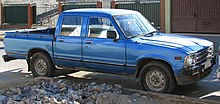 Fourth generation (N50, N60, N70; 1983–1988)
Fourth generation (N50, N60)
Fourth generation (N50, N60, N70; 1983–1988)
Fourth generation (N50, N60)
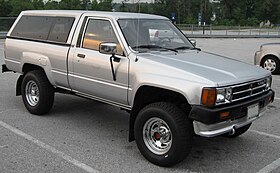 Overview
Also called
Toyota 1 Ton
Production
August 1983 – August 1988
Model years
1984–1988
Assembly
Toyota City, Japan
Hino Motors – Hamura, Tokyo, Japan
Tahara, Aichi, Japan
Montevideo, Uruguay, South America
Body and chassis
Body style
2 and 4-door truck
Layout
Front engine, rear-wheel drive / four-wheel drive
Related
Powertrain
Engine
1.6 L 1Y I4
2.0 L 3Y I4
2.4 L 22R I4
2.4 L 22R-E I4
2.4 L 22R-TE turbo I4
3.0 L 3VZ-E V6
2.2 L L I4 diesel
2.4 L 2L I4 diesel
2.4 L 2L-T I4 diesel turbo
Transmission
4/5-speed manual
3/4-speed automatic
Dimensions
Wheelbase
Regular Cab Short Bed: 2,616 mm (103.0 in)
Regular Cab Long Bed: 2,845 mm (112.0 in)
Xtracab Long Bed: 3,086 mm (121.5 in)
Length
Regular Cab Short Bed: 4,435 mm (174.6 in)
Regular Cab Long Bed: 4,729 mm (186.2 in)
Xtracab Long Bed: 4,966 mm (195.5 in)
Xtracab SR5: 4,676 mm (184.1 in)
Reg. Cab 4WD: 4,729 mm (186.2 in)
Width
Regular Cab: 1,621 mm (63.8 in)
Xtracab Long Bed: 1,679 mm (66.1 in)
Xtracab: 1,689 mm (66.5 in)
Height
Regular Cab Short Bed 2WD: 1,544 mm (60.8 in)
Regular Cab Long Bed: 1,534 mm (60.4 in)
Xtracab Long Bed: 1,532 mm (60.3 in)
1 t Reg. Cab Long Bed 2WD: 1,562 mm (61.5 in)
Regular Cab 4WD: 1,709 mm (67.3 in)
SR5 Turbo Xtracab: 1,529 mm (60.2 in)
Xtracab 4WD: 1,704 mm (67.1 in)
Curb weight
1,270 kg (2,800 lb)
Overview
Also called
Toyota 1 Ton
Production
August 1983 – August 1988
Model years
1984–1988
Assembly
Toyota City, Japan
Hino Motors – Hamura, Tokyo, Japan
Tahara, Aichi, Japan
Montevideo, Uruguay, South America
Body and chassis
Body style
2 and 4-door truck
Layout
Front engine, rear-wheel drive / four-wheel drive
Related
Powertrain
Engine
1.6 L 1Y I4
2.0 L 3Y I4
2.4 L 22R I4
2.4 L 22R-E I4
2.4 L 22R-TE turbo I4
3.0 L 3VZ-E V6
2.2 L L I4 diesel
2.4 L 2L I4 diesel
2.4 L 2L-T I4 diesel turbo
Transmission
4/5-speed manual
3/4-speed automatic
Dimensions
Wheelbase
Regular Cab Short Bed: 2,616 mm (103.0 in)
Regular Cab Long Bed: 2,845 mm (112.0 in)
Xtracab Long Bed: 3,086 mm (121.5 in)
Length
Regular Cab Short Bed: 4,435 mm (174.6 in)
Regular Cab Long Bed: 4,729 mm (186.2 in)
Xtracab Long Bed: 4,966 mm (195.5 in)
Xtracab SR5: 4,676 mm (184.1 in)
Reg. Cab 4WD: 4,729 mm (186.2 in)
Width
Regular Cab: 1,621 mm (63.8 in)
Xtracab Long Bed: 1,679 mm (66.1 in)
Xtracab: 1,689 mm (66.5 in)
Height
Regular Cab Short Bed 2WD: 1,544 mm (60.8 in)
Regular Cab Long Bed: 1,534 mm (60.4 in)
Xtracab Long Bed: 1,532 mm (60.3 in)
1 t Reg. Cab Long Bed 2WD: 1,562 mm (61.5 in)
Regular Cab 4WD: 1,709 mm (67.3 in)
SR5 Turbo Xtracab: 1,529 mm (60.2 in)
Xtracab 4WD: 1,704 mm (67.1 in)
Curb weight
1,270 kg (2,800 lb)
The August 1983 redesign (sold as model year 1984 vehicles in North America) introduced the Xtracab extended cab option, with six inches of space behind the seat for in-cab storage. These "1984" models carried over the carbureted 22R engine while model year 1984 also saw the introduction of the fuel injected 22R-E. Two diesel engines were also offered, the 2L and the turbocharged 2L-T. The diesels were discontinued in the U.S. after the 1986 model year, this was due to higher performance expectations from customers and the wide availability of inexpensive gasoline. The next year saw the introduction of a turbocharged option, the 22R-TE, perhaps due to increasing competition from Nissan who already offered a V6 truck at this time. The solid front axle was swapped out for an independent front suspension/torsion bar setup in the 4×4 model in 1986, and optional automatic differential disconnect for the front differential (an alternative to automatic locking hubs) and an electronic transfer case was added as well. A V6 engine was introduced in 1988. The Hilux-based 4Runner which made its entry in Australia, North America and the United Kingdom was based on this generation Hilux; in some other markets, such as Japan, it was called the Hilux Surf.
Toyota introduced a new generation of the Hilux in most markets in late 1988 but the fourth generation remained in production until 1997 in South Africa. Toyota says this was due to South African "content laws" which made it cheaper to continue to produce the fourth generation Hilux, rather than to retool the plant for the fifth generation.[10]
Engines:
Calendar years capacity code features power torque comments 1983–1987 2,366 cc 22R I4 SOHC 72 kW (98 PS; 97 hp) at 4800 rpm 174 N·m (128 lb·ft) at 2800 rpm 1983–1985 2,188 cc L I4 Diesel 46 kW (63 PS; 62 hp) at 4200 rpm 126 N·m (93 lb·ft) at 2200 rpm SR5 long bed only 1983–1988 2,446 cc 2L I4 Diesel 62 kW (84 PS; 83 hp) at 4200 rpm 165 N·m (122 lb·ft) at 2200 rpm 1986–1988 2,446 cc 2L-T I4 Diesel FI turbo 69 kW (94 PS; 93 hp) at 4000 rpm 216 N·m (159 lb·ft) at 2400 rpm 1983–1988 2,366 cc 22R-E I4 SOHC FI 78 kW (106 PS; 105 hp) at 4800 rpm 185 N·m (136 lb·ft) at 2800 rpm 1985–1986 2,366 cc 22R-TE I4 SOHC FI turbo 101 kW (137 PS; 135 hp) at 4800 rpm 234 N·m (173 lb·ft) at 2800 rpm 1987– 2,958 cc 3VZ-E V6 FI 112 kW (152 PS; 150 hp) at 4800 rpm 244 N·m (180 lb·ft) at 2400 rpm 1983– 1,626 cc 1Y I4 1983– 1,998 cc 3Y I4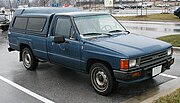
1984–1988 Toyota Pickup (US)
_2-door_utility_01.jpg/180px-1983-1988_Toyota_Hilux_(YN58R)_2-door_utility_01.jpg)
1983–1988 Toyota Hilux (YN58R) 2-door utility (Australia)
_4-door_utility_01.jpg/180px-1983-1988_Toyota_Hilux_(YN58R)_4-door_utility_01.jpg)
1983–1988 Toyota Hilux (YN58R) 4-door utility (Australia)
Fifth generation (N80, N90, N100, N110, N120, N130; 1988–1997) Fifth generation (N80, N90, N100, N110, N120, N130)_SR5_Xtra_Cab_2-door_utility_(2011-06-15)_01.jpg/280px-1994-1997_Toyota_Hilux_(RN110R)_SR5_Xtra_Cab_2-door_utility_(2011-06-15)_01.jpg) Overview
Also called
Toyota 4×2Toyota 4×4Volkswagen Taro
Production
August 1988–1997
Assembly
Tahara, Aichi, JapanHamura, JapanZárate, ArgentinaFremont, CaliforniaEnvigado, ColombiaSanta Rosa, Laguna, Philippines,Christchurch, New ZealandHanover, Germany (VW)
Body and chassis
Body style
2-door, 4-door truck
Layout
Front engine, rear-wheel drive / four-wheel drive
Related
4Runner/Hilux SurfPradoClassic
Powertrain
Engine
1.8 L 2Y-U I42.4 L 22R-E I43.0 L 3VZ-E V62.4 L 2L diesel I42.8 L 3L diesel I4
Transmission
four-speed manualfive-speed manualfour-speed automatic
Dimensions
Wheelbase
regular cab: 2,616 mm (103.0 in)regular cab long bed: 2,850 mm (112.2 in)Xtracab: 3,086 mm (121.5 in)Xtracab V6: 3,096 mm (121.9 in)
Length
regular cab: 4,435 mm (174.6 in)regular cab long bed: 4,724 mm (186.0 in)Xtracab: 4,905 mm (193.1 in)DLX regular cab long bed 4WD: 4,719 mm (185.8 in)DLX regular cab 4WD: 4,430 mm (174.4 in)
Width
1,689 mm (66.5 in)
Height
1988–91 regular cab: 1,544 mm (60.8 in)1988–91 regular cab long bed: 1,539 mm (60.6 in)1988–91 Xtracab 2WD: 1,549 mm (61.0 in)1988–91 regular cab long bed 4WD: 1,704 mm (67.1 in)1988–91 Xtracab 4WD: 1,709 mm (67.3 in)1991–97 regular cab: 1,590 mm (62.6 in)1991–97 regular cab: 1,595 mm (62.8 in)1991–97 Xtracab 4WD: 1,755 mm (69.1 in)1991–97 regular cab 4WD: 1,750 mm (68.9 in)
Overview
Also called
Toyota 4×2Toyota 4×4Volkswagen Taro
Production
August 1988–1997
Assembly
Tahara, Aichi, JapanHamura, JapanZárate, ArgentinaFremont, CaliforniaEnvigado, ColombiaSanta Rosa, Laguna, Philippines,Christchurch, New ZealandHanover, Germany (VW)
Body and chassis
Body style
2-door, 4-door truck
Layout
Front engine, rear-wheel drive / four-wheel drive
Related
4Runner/Hilux SurfPradoClassic
Powertrain
Engine
1.8 L 2Y-U I42.4 L 22R-E I43.0 L 3VZ-E V62.4 L 2L diesel I42.8 L 3L diesel I4
Transmission
four-speed manualfive-speed manualfour-speed automatic
Dimensions
Wheelbase
regular cab: 2,616 mm (103.0 in)regular cab long bed: 2,850 mm (112.2 in)Xtracab: 3,086 mm (121.5 in)Xtracab V6: 3,096 mm (121.9 in)
Length
regular cab: 4,435 mm (174.6 in)regular cab long bed: 4,724 mm (186.0 in)Xtracab: 4,905 mm (193.1 in)DLX regular cab long bed 4WD: 4,719 mm (185.8 in)DLX regular cab 4WD: 4,430 mm (174.4 in)
Width
1,689 mm (66.5 in)
Height
1988–91 regular cab: 1,544 mm (60.8 in)1988–91 regular cab long bed: 1,539 mm (60.6 in)1988–91 Xtracab 2WD: 1,549 mm (61.0 in)1988–91 regular cab long bed 4WD: 1,704 mm (67.1 in)1988–91 Xtracab 4WD: 1,709 mm (67.3 in)1991–97 regular cab: 1,590 mm (62.6 in)1991–97 regular cab: 1,595 mm (62.8 in)1991–97 Xtracab 4WD: 1,755 mm (69.1 in)1991–97 regular cab 4WD: 1,750 mm (68.9 in)
The next redesign, in 1988, produced a longer-wheelbase option, 3,099 mm (122 in) rather than 2,616 mm (103 in) for the regular wheelbase. Its one-piece cargo-box walls eliminated the rust-prone seams that were found in earlier models. The V6 Xtracab SR5 earned Motor Trend magazine's Truck of the Year award that year. The Xtracabs now featured more room behind the front seats than the last generation which allowed optional jump-seats for rear passengers, a feature more in line with competitors of the time.
In 1991, American production began at the NUMMI plant in Fremont, California (the VIN on these cars starts with '4T'), however some trucks sold in the United States during the 91–95 model years were still manufactured in Japan (VIN starts with 'JT').
The Hilux received a minor facelift in 1991 (for the 1992 model year), which was a minor grille change and the new Toyota emblem that had been recently adopted.
It was during this generation that Toyota discontinued the Hilux in the United States, replacing it with the new Tacoma in 1995.
Engines:
1988–1995: 1.8 L (1,812 cc) 2Y-U I4, 58 kW (79 PS; 78 hp) at 5,000rpm 140 N·m (100 lb·ft) at 3,200rpm2Y I4, 61 kW (83 PS; 82 hp) at 4,800rpm 140 N·m (100 lb·ft) at 2,800rpm (export markets)[11]
1989–1997: 2.4 L (2,366 cc) 22R-E SOHC EFI I4, 84 kW (114 PS; 113 hp) at 4,600 rpm and 192 N·m (142 lb·ft) at 3,400 rpm 1989–1995: 3.0 L (2,958 cc) 3VZ-E V6, 112 kW (152 PS; 150 hp) at 4,800 rpm 1989–1997: 2.4 L (2,446 cc) 2L-II diesel I4, 66 kW (90 PS; 89 hp) at 4,200 rpm and 167 N·m (123 lb·ft) at 2,400 rpm[12] 2.8 L (2,779 cc) 3L diesel I4, 67 kW (91 PS; 90 hp) at 4,000 rpm and 188 N·m (139 lb·ft) at 2,400 rpmVolkswagen built and marketed them under the Volkswagen Taro name from February 1989 to March 1997.
South AmericaFor sales in Colombia, Ecuador and Venezuela, the Hilux was produced in Colombia from 1994 to 1998 by the SOFASA company (only equipped with the 2.4 l petrol engine). For sales in Argentina, Brazil, and Uruguay, the Hilux was produced in Argentina from 1997 through 2005 (Zárate Plant – both petrol and diesel engines). For sales in Bolivia, Chile, Paraguay and Peru, the Hilux was imported from factories in Japan from 1989 to 1997 (petrol and diesel engines).
South American markets:
single cab chassis (2WD, 4WD petrol engines) (Colombia and Ecuador) single cab long bed (2WD,4WD, petrol and diesel engines) (all South American countries; diesel engine not available in Colombia, Ecuador and Venezuela) xtra cab (2WD, 4WD, petrol) (Only Bolivia) crew cab (2WD,4WD, petrol and diesel engines)(All South American countries; Diesel engine not available in Colombia, Ecuador and Venezuela)_cab_chassis_02.jpg/180px-1988-1991_Toyota_Hilux_(RN85R)_cab_chassis_02.jpg)
1988–1991 Hilux cab chassis (Australia)
_front.jpg/180px-1994-1995_Toyota_Pickup_RN80_(US)_front.jpg)
Toyota Pickup 2WD 2-door (US)

1991 Volkswagen Taro 2-door (Germany)

Toyota Pickup V6 Xtra Cab (US)
_SR5_Xtra_Cab_2-door_utility_(2011-06-15)_02.jpg/180px-1994-1997_Toyota_Hilux_(RN110R)_SR5_Xtra_Cab_2-door_utility_(2011-06-15)_02.jpg)
1994–1997 Toyota Hilux SR5 Xtra Cab (Australia)
_DX_4-door_utility_(2007-09-28).jpg/180px-1990-1997_Toyota_Hilux_(LN106R)_DX_4-door_utility_(2007-09-28).jpg)
4-door (Australia)

Rare 4-door Xtra Cab (Thailand)
Sixth generation (N140, N150, N160, N170; 1997–2005) Sixth generation (N140, N150, N160, N170)_2-door_utility_(2011-07-17)_01.jpg/280px-1997-2001_Toyota_Hilux_(RZN149R)_2-door_utility_(2011-07-17)_01.jpg) Overview
Production
1997–2005
Assembly
Hino Motors, Hamura, JapanEnvigado, ColombiaSanta Rosa, Laguna, PhilippinesSamut Prakan, ThailandCumaná, Venezuela
Body and chassis
Body style
2-door truck4-door truck
Layout
Front engine, rear-wheel drive / four-wheel drive
Related
4Runner/Hilux SurfToyota Hilux Sport Rider
Powertrain
Engine
2.0 L I42.4 L I42.7 L I43.4 L V62.4 L D-4D turbo diesel2.5 L D-4D turbo diesel2.8 L diesel I43.0 L diesel I4
Transmission
5-speed manual4-speed automatic
Dimensions
Wheelbase
Regular Cab: 2,850 mm (112.2 in)Extended Cab: 3,090 mm (121.7 in)Crew Cab: 2,855 mm (112.4 in)
Length
Regular Cab: 4,690 mm (184.6 in)Extended Cab: 5,035 mm (198.2 in)Crew Cab: 4,790 mm (188.6 in)
Width
Regular Cab & All 2WD Models: 1,665 mm (65.6 in)Crew Cab & Extended Cab: 1,790 mm (70.5 in)
Height
Overview
Production
1997–2005
Assembly
Hino Motors, Hamura, JapanEnvigado, ColombiaSanta Rosa, Laguna, PhilippinesSamut Prakan, ThailandCumaná, Venezuela
Body and chassis
Body style
2-door truck4-door truck
Layout
Front engine, rear-wheel drive / four-wheel drive
Related
4Runner/Hilux SurfToyota Hilux Sport Rider
Powertrain
Engine
2.0 L I42.4 L I42.7 L I43.4 L V62.4 L D-4D turbo diesel2.5 L D-4D turbo diesel2.8 L diesel I43.0 L diesel I4
Transmission
5-speed manual4-speed automatic
Dimensions
Wheelbase
Regular Cab: 2,850 mm (112.2 in)Extended Cab: 3,090 mm (121.7 in)Crew Cab: 2,855 mm (112.4 in)
Length
Regular Cab: 4,690 mm (184.6 in)Extended Cab: 5,035 mm (198.2 in)Crew Cab: 4,790 mm (188.6 in)
Width
Regular Cab & All 2WD Models: 1,665 mm (65.6 in)Crew Cab & Extended Cab: 1,790 mm (70.5 in)
Height
4WD Regular Cab/Extended Cab: 1,775 mm (69.9 in)4WD Crew Cab: 1,795 mm (70.7 in)2WD Regular Cab: 1,600 mm (63.0 in)/1,650 mm (65.0 in)
2WD Extended & Crew Cab:1,695 mm (66.7 in)Engines:
1998–2001 2.0 L (1,998 cc) 1RZ-E 8 Valve SOHC I4 (Hilux 'Workmate' models in Australia) (4×2) 1998–1999 3.0 L (2,986 cc) 5L diesel I4, 72 kW (98 PS; 97 hp) (4×4) 1995–2004 2.4 L (2438 cc) 2RZ-FE 16-valve DOHC I4, 106 kW (144 PS; 142 hp) (4×2) 1995–2004 2.7 L (2693 cc) 3RZ-FE 16-valve DOHC I4, 112 kW (152 PS; 150 hp) (4×4) 1995–2004 3.4 L 5VZ-FE 24-valve DOHC V6, 142 kW (193 PS; 190 hp) South AmericaThe Hilux was produced in Colombia for sales in Colombia, Venezuela, and Ecuador from 1998 to 2005 by the SOFASA company (with only petrol engines 2.7 L). In Venezuela and Ecuador, the single-cab 2WD chassis/long bed is called the Stout II). For sales in Bolivia, Chile, Paraguay, Peru, it was imported from Japan from 1998 through 2004 (petrol engined 2.7 L, and diesel engined 2.8 L). This model was not sold in Argentina or Brazil because the fifth generation Hilux had received a redesign and upgrade.
South American markets:
single cab chassis (2WD, 4WD petrol engines) (for sales in Colombia and Ecuador) single cab long bed (2WD,4WD, petrol and diesel engines) (all South American countries) Xtracab (4WD, petrol and diesel engines) (in Bolivia only) crew cab (2WD,4WD, petrol and diesel engines)(all South American countries) (Named the Hilux Millenium from 2002 through the present) ThailandToyota shifted production from the Hilux Mighty-X (fifth generation) to the Hilux Tiger (sixth generation) in the late 1990s and made it the global export hub. The Thailand-made Hilux Tiger went through the following versions:
1998–1999: Hilux Tiger with the 3.0 L 5L engine 2000–2001: Hilux Tiger with the 3.0 L 5L-E EFI engine 2001: Hilux Tiger with 1KZ engine (short lived replaced right away with D4D engine) Late 2001 – late 2004: Hilux Tiger SportCruiser with D4D engine[13]In 2005, Toyota ceased production of the Hilux truck for the Japanese market. This was the last generation Hilux to be available (or built) in Japan.
Pickup 4WD Wide Extra cab Sports 2.7 L (RZN174H, Japan)
Pickup 4WD Wide Extra cab Sports 2.7 L (RZN174H, Japan
_2-door_utility_(2011-07-17)_02.jpg/211px-1997-2001_Toyota_Hilux_(RZN149R)_2-door_utility_(2011-07-17)_02.jpg)
1997–2001 Toyota Hilux (RZN149R) 2-door utility, Australia
_4-door_utility_01.jpg/201px-2001-2004_Toyota_Hilux_(RZN149R_MY02)_4-door_utility_01.jpg)
2001–2004 (before change to single glass in front doors)(RZN149R, Australia)
_SR5_4-door_utility_01.jpg/202px-2002-2005_Toyota_Hilux_(VZN167R)_SR5_4-door_utility_01.jpg)
2002–2005 Toyota Hilux SR5 4-door utility(VZN167R, Australia)
Post faceliftPickup 4WD Wide Double cab Sports 2.7 (RZN169H, Japan)
Hilux Sport RiderToyota introduced a mid-size SUV variant of the Hilux in 1998 for a select few markets, known as the Hilux Sport Rider. The Sport Rider is a rare model, sold in a select few Asian markets, including Thailand and Nepal. Based on the Hilux, both in style and underpinnings, it is similar in concept to the Toyota 4Runner—however, the Sport Rider is not a rebadged 4Runner. The Sport Rider frame and suspensions are derived from the Hilux, including the Hilux's independent front suspension and leaf-sprung rear. The model started out as the four-door pickup truck, but were modified into wagons on arrival in Thailand by Thai Auto Works Co, a majority Thai-owned company in which Toyota has a 20 percent stake. The vehicles were distributed by Toyota Tsusho Thailand, the importer of Toyota forklifts.
The Sport Rider arrived in 1998 with the 5L engine for Prerunner (2WD) and 5L-E for 4WD, later 1KZ-TE for 4WD only arrived in 2001 and foglamp built in front bumper, and 2002 new engines arrived—the 1KD-FTV and 2KD-FTV with new front bumper, new front lamp is projector, and new rear lamp. Toyota discontinued the Sport Rider in 2004, replaced in 2005 with the Toyota Fortuner.
Engines:
1998–2002: 3.0 L (2,986 cc) 5L-E I4 SOHC EFI, 77 kW (105 PS; 103 hp) at 4,000 rpm 200 N·m (150 lb·ft) at 2,600 rpm 1998–2002: 3.0 L (2,986 cc) 5L I4, 72 kW (98 PS; 97 hp) at 4,000 rpm 192 N·m (142 lb·ft) at 2,400 rpm (Prerunner) 2001–2002: 3.0 L (2,982 cc) 1KZ-TE I4 SOHC, 92 kW (125 PS; 123 hp) at 3,600 rpm and 315 N·m (232 lb·ft) at 2,000 rpm 2002–2004: 3.0 L (2,982 cc) 1KD-FTV I4 DOHC, 93 kW (126 PS; 125 hp) at 4,800 rpmand 315 N·m (232 lb·ft) at 1,800–2,600 rpm 2002–2004: 2.5 L (2,494 cc) 2KD-FTV I4 DOHC, 75 kW (102 PS; 101 hp) at 3,600 rpm and 260 N·m (190 lb·ft) at 1,400–3,400 rpm
1998–2002 Toyota Hilux Sport Rider with 5L

2001–2002 Toyota Hilux Sport Rider with 1KZ

2002–2004 Toyota Hilux Sport Rider with 1KD

2002–2004 Toyota Hilux Sport Rider with 1KD

2002–2004 Toyota Hilux Sport Rider Prerunner with 2KD

2002–2004 Toyota Hilux Sport Rider Prerunner with 2KD
Seventh generation (AN10, AN20; 2005–2015) Seventh generation (AN10, AN20) Overview
Also called
Toyota Hilux Vigo (Thailand)
Production
April 2005 – August 2015
Assembly
Zarate, ArgentinaCumaná, VenezuelaKarachi, PakistanChachoengsao, Thailand[14][15]Samut Prakan, ThailandDurban, South AfricaGuangzhou, China
Body and chassis
Body style
2-door truck4-door truck
Layout
Front engine, rear-wheel drive / four-wheel drive
Related
FortunerInnova
Powertrain
Engine
Petrol:
2.0 L 1TR-FE I4
2.7 L 2TR-FE I4
4.0 L 1GR-FE V6
Diesel:
2.5 L 2KD-FTV turbodiesel I4
2.5 L 2KD-FTV intercooled turbodiesel I4
2.5 L 2KD-FTV intercooled VNT diesel I4
3.0 L 1KD-FTV intercooled VNT diesel I4
Transmission
5-speed manual4-speed automatic5-speed automatic
Dimensions
Wheelbase
Single Cab: 2,750 mm (108.3 in) 3,085 mm (121.5 in)
Length
Regular Cab: 4,980 mm (196.1 in)Extended Cab: 5,135–5,260 mm (202.2–207.1 in)Crew Cab: 4,980–5,260 mm (196.1–207.1 in)
Width
Regular Cab & All 2WD Models: 1,760 mm (69.3 in)Crew Cab & Extended Cab: 1,835 mm (72.2 in)
Height
4WD Regular Cab: 1,795 mm (70.7 in)4WD Crew Cab & Extended Cab: 1,810 mm (71.3 in)2WD Regular Cab: 1,680 mm (66.1 in)2WD Extended & Crew Cab: 1,695 mm (66.7 in)
Overview
Also called
Toyota Hilux Vigo (Thailand)
Production
April 2005 – August 2015
Assembly
Zarate, ArgentinaCumaná, VenezuelaKarachi, PakistanChachoengsao, Thailand[14][15]Samut Prakan, ThailandDurban, South AfricaGuangzhou, China
Body and chassis
Body style
2-door truck4-door truck
Layout
Front engine, rear-wheel drive / four-wheel drive
Related
FortunerInnova
Powertrain
Engine
Petrol:
2.0 L 1TR-FE I4
2.7 L 2TR-FE I4
4.0 L 1GR-FE V6
Diesel:
2.5 L 2KD-FTV turbodiesel I4
2.5 L 2KD-FTV intercooled turbodiesel I4
2.5 L 2KD-FTV intercooled VNT diesel I4
3.0 L 1KD-FTV intercooled VNT diesel I4
Transmission
5-speed manual4-speed automatic5-speed automatic
Dimensions
Wheelbase
Single Cab: 2,750 mm (108.3 in) 3,085 mm (121.5 in)
Length
Regular Cab: 4,980 mm (196.1 in)Extended Cab: 5,135–5,260 mm (202.2–207.1 in)Crew Cab: 4,980–5,260 mm (196.1–207.1 in)
Width
Regular Cab & All 2WD Models: 1,760 mm (69.3 in)Crew Cab & Extended Cab: 1,835 mm (72.2 in)
Height
4WD Regular Cab: 1,795 mm (70.7 in)4WD Crew Cab & Extended Cab: 1,810 mm (71.3 in)2WD Regular Cab: 1,680 mm (66.1 in)2WD Extended & Crew Cab: 1,695 mm (66.7 in)
Following the February 2004 introduction of the 2005 model year Tacoma, the 7th generation Hilux was unveiled on March 2, 2005 in Buenos Aires, Argentina. Market launch later began in April 2005. The Tacoma was based on the 4Runner chassis, while the Hilux rides on an revamped version of the ladder frame found on previous versions. The Hilux increased in size and then became classified as a mid-size pick up. The Tacoma had a new 4.0 L V6 engine that produces 176 kW (236 hp) and 361 N·m (266 lb·ft) of torque. Its design was very similar to the 4Runner.[16]
Hilux models sold in Australian, Middle Eastern, and Asian markets are built and assembled in Thailand, where the vehicle is called the Hilux Vigo, or simply Vigo. For the European and South African markets the Hilux is built in Durban, South Africa. As of December 2009, it is the best selling vehicle in South Africa. Those sold in South America are made in Argentina, as with the previous generation Hilux.[17] However, the engines are built in Japan (where they are also used in the Prado) instead of Argentina.[citation needed] In Asia, the Hilux Vigo platform was used as the basis for Toyota's IMV program which spawned the Innova MPV and Fortuner SUV/PPV.
_SR5_4-door_utility_(2011-04-22).jpg/220px-2006_Toyota_Hilux_(GGN25R_MY05)_SR5_4-door_utility_(2011-04-22).jpg)
In Malaysia, the Hilux is only available in 2.5 L with the option of single cab or double cab.[citation needed] The double cab model has an automatic transmission variant. It uses the same engine as other Asian countries (in-line, 4-cylinder, 16-valve, DOHC Turbo Diesel with common rail direct injection), however engines used in Malaysia differ in their maximum output of 75 kW (101 hp) at 3600 rpm and maximum torque of 260 N·m (192 lbf·ft) at 1600–2400 rpm.
In Singapore, the Hilux is available as a single cab with the 2.5 L engine or a double cab with the 3.0 L engine. Notable fleet customers include private taxi operators, for whom the double cab model offers additional load space versatility, and the Singapore Police Force and Pakistan Police, which employs it as a patrol vehicle.
The Hilux will be built in Guangqi Toyota Automobile in Guangzhou for the Chinese market. The models for China will be 4.0 L with the option of single cab or double cab. It uses the same engine as Australia (V6, 24-valve, DOHC), however engines used in China has been tuned up to the maximum output of 246 kW (330 hp) at 6500 rpm and maximum torque of 405 N·m (299 lbf·ft) at 4000 rpm, and is mated to a 5-speed automatic transmission. China is the only Asian country to get the V6 engine.
Two Hilux pickups were entered in recent years of the Dakar Rally by the Imperial Toyota team of South Africa. Driver Giniel de Villiers achieved third place in 2012, second place overall in 2013, 4th in 2014, and again second place in 2015. These however, were heavily modified non-production versions built around a custom racing-only tubular chassis and using a larger capacity Toyota V8 engine.[18]
Engines (markets):
2005 2.0 L gasoline VVT-i DOHC I4 (South Africa, Indonesia[19] and Middle East) 2005 2.5 L diesel D-4D DOHC I4, 76 kW (102 hp) – 107 kW (145 PS; 143 hp) (Asia, Europe, South Africa, South America) 2005 2.7 L gasoline VVT-i DOHC I4, 119 kW (162 PS; 160 hp) (Australia, Arabian Peninsula, The Philippines, South Africa, Venezuela) 2005 3.0 L diesel D-4D DOHC I4, Turbodiesel, commonrail 16-valve direct injection, 121 kW (165 PS; 162 hp) (Asia, South Africa, South America, Australia, Europe). This version is made at Toyota's facility in Zárate, Argentina. 2005 4.0 L gasoline VVT-i DOHC V6, 170 kW (231 PS; 228 hp) – 176 kW (236 hp) (Australia, South Africa, Venezuela, China) 2008 4.0 L Supercharged DOHC V6 225 kW (306 PS; 302 hp) (Australia only, TRD edition) 2008 faceliftA facelifted version of the Hilux was unveiled by Toyota's Malaysian distributors, UMW Toyota Motor, in August 2008. Toyota has released a left hand drive facelifted Hilux Vigo in August 2008 while a right hand drive facelifted model is expected to be released in September 2008.[20] These facelifted models were introduced to the Philippines in October 2008.
Toyota also introduced a rear access system called "Smart Cab" to replace all Xtra Cab models in E and G grade. The Smart Cab models are only for the Thailand domestic market.[citation needed]
2011 faceliftOn 13 July 2011, Toyota announced that the Hilux would receive an upgrade, including a redesigned front end and other external styling changes, changes to the interior and a new turbocharged diesel engine capable of 106 kW (142 hp) and 343 N·m (253 lb·ft) of torque, as well as lower fuel consumption compared to the previous model.[21] This update was initially launched in Thailand.[22]
The Thailand version of 2012 Toyota Hilux Vigo "Champ" is a significant "minor" change with a new front look and a revamped interior to reinforce perceived luxuriousness. The front is redesigned from the A pillar forwards. With the exception of doors, roofs and tailgates, everything else is new: new guards, new headlights, new bumper, new bonnet, new three-bar grille, new taillights, a new rear bumper, new models badge and other. There are also new mirrors and new alloy wheel designs. The interior features a new upper dashboard design with a new horizontal centre instrument cluster. Perceived quality has been improved through the adoption of uniformly darker finishes with greater colour consistency throughout the interior. The high-end Double Cab version now comes with a DVD player, rear camera and Bluetooth functionality.[23]
_4000SL_4-door_utility_01.jpg/173px-2008_TRD_Hilux_(GGN25R)_4000SL_4-door_utility_01.jpg)
TRD Hilux (GGN25R) 4000SL 4-door utility (Australia)
_SR5_Xtra_Cab_2-door_utility_01.jpg/180px-2005-2008_Toyota_Hilux_(GGN15R)_SR5_Xtra_Cab_2-door_utility_01.jpg)
Xtra Cab
_SR5_4-door_utility_01.jpg/180px-2005-2008_Toyota_Hilux_(KUN26R)_SR5_4-door_utility_01.jpg)
Toyota Hilux (KUN26R) SR5 4-door utility (Australia; pre-facelift)

2009 Single cab
_SR_4-door_utility_(2011-04-22).jpg/180px-2010-2011_Toyota_Hilux_(GGN15R_MY10)_SR_4-door_utility_(2011-04-22).jpg)
Toyota Hilux (GGN15R) SR 4-door utility (Australia; 2008 facelift)
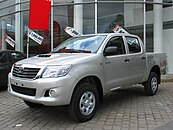
2011 facelift
2013 model updateIn August 2012, Toyota updated Toyota Hilux Vigo "Champ" in Thailand to 2013 model. This minor update upgraded emission standard to Euro-4, updated 4-speed automatic transmission to 5-speed transmission, upgraded performance of 3000 cc Vigo from 163HP to 171HP and upped torque from 343Nm to 360Nm; and Prerunner 4x2 was introduced in Auto. Other changes included more efficient fuel injection system and addition of center headrest on rear double cab seat.[24]
Eighth generation (M70, M80; 2015–present) Eighth generation Overview
Also called
Toyota Hilux Revo (Thailand, Laos)
Production
2015–present
Assembly
Samut Prakan, Thailand
Body and chassis
Body style
2-door truck (S-Cab)4-door truck (Extra Cab & D-Cab)
Layout
Front engine, rear-wheel drive / four-wheel drive
Related
Toyota FortunerToyota Innova
Powertrain
Engine
Petrol:
2.7 L 2TR-FE I4
4.0 L 1GR-FE V6
Diesel:
2.4 L 2GD-FTV VNT I4
2.5 L 2KD-FTV VNT I4
2.8 L 1GD-FTV VNT I4
3.0 L 1KD-FTV VNT I4
Transmission
5-speed manual6-speed manual5-speed automatic6-speed automatic
Dimensions
Wheelbase
Crew Cab: 3,085 mm (121.5 in)
Length
Crew Cab: 5,335 mm (210.0 in)
Width
Crew Cab: 1,855 mm (73.0 in)
Height
Crew Cab 1,820 mm (71.7 in)
Overview
Also called
Toyota Hilux Revo (Thailand, Laos)
Production
2015–present
Assembly
Samut Prakan, Thailand
Body and chassis
Body style
2-door truck (S-Cab)4-door truck (Extra Cab & D-Cab)
Layout
Front engine, rear-wheel drive / four-wheel drive
Related
Toyota FortunerToyota Innova
Powertrain
Engine
Petrol:
2.7 L 2TR-FE I4
4.0 L 1GR-FE V6
Diesel:
2.4 L 2GD-FTV VNT I4
2.5 L 2KD-FTV VNT I4
2.8 L 1GD-FTV VNT I4
3.0 L 1KD-FTV VNT I4
Transmission
5-speed manual6-speed manual5-speed automatic6-speed automatic
Dimensions
Wheelbase
Crew Cab: 3,085 mm (121.5 in)
Length
Crew Cab: 5,335 mm (210.0 in)
Width
Crew Cab: 1,855 mm (73.0 in)
Height
Crew Cab 1,820 mm (71.7 in)
The eighth generation Toyota Hilux was officially released simultaneously on 21 May 2015 in Bangkok, Thailand and Sydney, Australia.[25] The Thai and Lao market also adopted a new name, Toyota Hilux Revo. The Hilux uses the "Keen Look" design language that has already been used in the Toyota Corolla (E170) with slim projector headlights and LED DRL (Daytime Running Lights). This design continues into the interior with similar AC vent and center fascia design. This generation features Toyota's first autonomous emergency braking (AEB).[26] New ESTEC GD 2.4-litre, 2.8-litre and KD 2.5 litre, 3.0 litre diesel engines, shared with the Fortuner and Innova, were combined with a five- or six-speed manual transmission or a five- or six-speed automatic transmission with sequential shift.[27] The 2.8-litre GD engine was introduced in May 2015 at the 36th International Vienna Motor Symposium.[28] The 2.7- and 4.0-litre petrol engines from the previous generation will be reused with some updates to increase power and torque. However, the car would hit the showrooms in October, 5 months after its official release.[29][30]
Model Engine Transmission Power Torque 2.4 2.4 L 2GD-FTV inline-4 common rail diesel with VNT 6-speed manual 110 kW (150 hp) at 3400 rpm 343 N·m (253 lb·ft) at 1400–2600 rpm 6-speed automatic 400 N·m (300 lb·ft) at 1600–2400 rpm 2.5 2.5 L 2KD-FTV inline-4 common rail diesel with VNT 6-speed manual 107 kW (144 hp) at 3400 rpm 343 N·m (253 lb·ft) at 1800–3400 rpm 5-speed automatic 2.7 2.7 L 2TR-FE inline-4 fuel-injected petrol with Dual VVT-i 6-speed manual 120 kW (160 hp) at 5500 rpm 246 N·m (181 lb·ft) at 3800 rpm 6-speed automatic 2.8 2.8 L 1GD-FTV inline-4 common rail diesel with VNT 6-speed manual 132 kW (177 hp) at 3400 rpm 420 N·m (310 lb·ft) at 1400–2600 rpm 6-speed automatic 450 N·m (330 lb·ft) at 1600–2400 rpm 3.0 3.0 L 1KD-FTV inline-4common rail diesel with VNT
6-speed manual128 kW (171 hp) at 3400 rpm
360 N·m (270 lb·ft) at 1800–3400 rpm
5-speed automatic 4.0 4.0 L 1GR-FE V6 fuel-injected petrol with Dual VVT-i 6-speed manual 207 kW (278 hp) at 5200 rpm 376 N·m (277 lb·ft) at 3700 rpm 6-speed automatic ReputationThe Hilux has gained a reputation for exceptional sturdiness and reliability during sustained heavy use or even abuse, and has been referred to as "The Indestructible Truck"[citation needed]. This was further reinforced on the BBC motoring show Top Gear, when a 1988 diesel Hilux with 305,775 km (190,000 mi) on the odometer was subjected to extraordinary abuse (in series 3, episodes 5 and 6). This consisted of driving it down a flight of steps, scraping buildings, crashing headlong into a tree, being washed out to sea, and being submerged in sea water for four hours, driving it through a garden shed, dropping a caravan onto it, hitting it with a wrecking ball, setting its cabin and bed area on fire,[31] and, finally, placing it on top of a 73 m (240 ft) block of apartments that was next destroyed by a building implosion.[32] Although it was now suffering from severe structural damage, the truck was still running after being repaired without spare parts, and with only typical tools that would be found in a truck's toolbox, such as screwdrivers, motor oil, and an adjustable wrench.[33] The Hilux rested as one of the background decorations in the Top Gear studio.
In the TV series of 2006, (series 8, episode 3), a Hilux was chosen by Jeremy Clarkson as his platform for creating an amphibious vehicle. With assistance, Clarkson rigged the truck with a massive outboard motor, and steering mechanism in the pickup bed. The truck, redubbed the "Toybota", was driven by Clarkson over several miles by road and 3.2 km (2 mi) across open water, before capsizing (three metres away from the finish) during a quick turn. Once recovered, the vehicle was moved back to the Top Gear Studio, where a confident Clarkson stated that he would be the only one capable of driving his truck home, since it was the indestructible Hilux. Clarkson had finally destroyed the "indestructible" after he could not get the Hilux started. When Clarkson turned the engine over, it produced a puffing and hissing sound as though the injectors or the heater plugs had been removed.
In 2007, Top Gear ran a special program in which Clarkson and James May raced a customized 2005 model Hilux to the magnetic north pole from Northern Canada against Richard Hammond using a dog sled, and won. This episode, known as the Top Gear Polar Special, made the truck the first motor vehicle to make it to the magnetic north pole. The Hilux used was slightly modified: larger wheels and thicker tyres were installed, a thick sump guard was installed, the front suspension was moved forward, a gun mount was installed, some powerful front lights were installed (although they were not needed, as it was still polar daytime at 23:30) and a toilet seat (first introduced as a joke Christmas present idea in Series 3 Episode 6 which also featured the Hilux challenge) was mounted on the rear bumper.
In 2010, the Top Gear host James May drove a modified Hilux, one which had served as the camera crew's vehicle during the 2007 polar special, to approach the summit of an erupting Icelandic volcano (Eyjafjallajökull) and retrieved a fragment of volcanic lava. The Hilux was modified for this task by the installation of a simple metal "umbrella" and alcohol cooling drips for its tyres (Series 15, Episode 1).
Outside of TV programs, these vehicles have been known to exceed 482,803 km (300,000 mi) with regular maintenance.[citation needed] It is also notorious for being used as an improvised fighting vehicle – a "technical" – by militias and irregular military forces, especially in Third World conflicts.[34] The 1980s Toyota War between Libya and Chad was so named because of the heavy use of Hilux trucks as light cavalry vehicles.[35]
In October 2007, the Swedish auto magazine Teknikens Värld performed an evasive manoeuvre (a moose test) that revealed that the manoeuvrability of Hilux pickup truck was deficient for turning sharply at moderate speeds. The truck failed the test and only the driver's skill prevented it from overturning. After the test Toyota stopped the sales of Hilux equipped with 16" wheels in Europe.
A world record was achieved by the support crew for the participants in the 2008/2009 Amundsen Omega 3 South Pole Race. The crew travelled in specially adapted Toyota Hilux's modified by Arctic Trucks, completing a trip of over 5,000 km (3,100 mi) from Novo, a Russian Scientific Station in Antarctica to the Geographic South Pole and back again, making them the first 4×4s to reach the South Pole. The return journey of 2,500 km (1,600 mi) from the South Pole to Novo Station was completed in a record 8 days and 17 hours.
A team of professional drivers use Toyota Hiluxes for a precision driving show throughout Australia. The Toyota Hilux Heroes began in 2007 and have been entertaining millions of spectators at various agricultural shows and motor sport events. The Hilux's are 2007 petrol V6, 4×2 models and have custom shock absorbers, a custom exhaust, sports seat, racing harnesses, a roll cage and 16 inch alloy wheels fitted. Performance highlights include high speed drifting, close formation driving, cross overs(where the cars race towards one another at speed), a 12-metre ramp jump and balancing a Hilux on two wheels all choreographed into a 15-minute show.
A fourth generation Hilux is also the vehicle mode for the Transformers Autobots Trailbreaker and Hoist.

The heavily damaged, but still working, Top Gear Hilux perched on its plinth
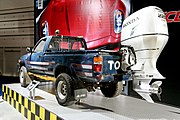
Jeremy Clarkson's Hilux Boat, redubbed the "Toybota"
 Ambulance car with Red Crescent emblem in Neyshabour, Iran.
Ambulance car with Red Crescent emblem in Neyshabour, Iran.
Toyota Hilux in the Sahel in Mauritania
-
2016 Toyota Hilux Redesign And New Engine - The Best New Cars
The nex-gen Toyota Hilux was recently seen on the road, or better to say, off-road. And even though it was completely camouflaged, we managed to figure out most of the changes. First of all, most obviously, the redesigned 2016 Toyota Hilux will be much larger than the current, wider and longer. The extrior bodywork was camouflaged, but not good enough, so we noticed all changes in the front end. It appears that the 2016 Toyota Hilux will get a completely new and a bit aggressive shape. However, all this seems more or less irrelevant, because, this ride was not just any test. It was the first test for a new engine under the 2016 Toyota Hilux hood. This pickup truck was spotted quite muddy, which tells us this was a first engine, off-road test. So, what is under the hood of the new Hilux?

current model
2016 Toyota Hilux With 5.0L Turbo Diesel Cummins V-8?Well, we think we know. The 2016 Toyota Hilux will be a world wide pickup truck, and with that comes the world famous engine, which leads us to the only option. The next-gen Hilux will roll up with 5.0L Turbo Diesel Cummins V-8, the same one that will be under the hood of 2016 Tundra. This engine delivers more than 300 horsepower and more than 500 lb.-ft. of torque, and is the perfect for the new and larger Hilux. A 5.0L Turbo Diesel Cummins V-8 will not be the only engine choice, but if it turns out to be true, will be the best one. A towing capabilities will be much more higher, as well as other performance for the next Hilux.

current model
2016 Toyota Hilux Exterior ChangesAs we said, the 2016 Toyota Hilux will have a different exterior appearance. A longer wheelbase and rear overhang suggest that will ride on some other platform, so although larger than before, the 2016 Hilux could come lighter. Yet this is an assumption. Still, what is clearly seen is a new front fascia is a new grille that just bulging beneath camouflage. It seems that will have one more bar. A front bumper is also restyled, as well as the headlights. Altogether, the 2016 Toyota Hilux will have more aggressive front fascia. The body-lines suggest the bigger shoulders and muscular appearance, which reveals a true off-roader. Inside, well we did not see, but the 2016 Hilux cab is definitely larger, which brings more space and even bigger comfort.
The 2016 Toyota Hilux will be more and more on the road, and this gives us the opportunity to see it again. So, as soon as we find out more, you will be notified.
Updated 02/04/2015: According to the latest rumors, the all-new 2016 Toyota Hilux won’t be that new as we expected. It seems that automaker doesn’t have a plan to install a 5.0L Turbo Diesel Cummins V-8 under the hood of this redesigned pickup truck. The 2016 Hilux will rather come with the existing 2.5 and 3-liter diesel variants, which should be renowned and boosted a bit. On the other hand, the current 2.7-four-cylinder and 4.0liter V6 gasoline engines could be replaced, but the automaker has not confirmed this rumors yet.
The all-new Toyota Hilux will make the debut late this year, and the estimated price goes from $18,000 to $20,000 for the base model.
Related posts:2015 Toyota Prius The Outstanding Hybrid
2016 Toyota Prius Gets Ultra-Efficient Hybrid System
2016 Toyota Tacoma Redesign -- Diesel And Hybrid Under The Hood?
Toyota C-HR Concept Premiere
2017 Toyota Camry -- Scheduled Redesign?
2016 Toyota Avalon -- Cosmetic Changes and Possibly New Engine
2016 Toyota Avalon -- Updated Exterior and Interior and a New XLE Plus Model
2016 Toyota Land Cruiser Update -- Redesigned Body and Maybe a New Engine

-
Hilux / Fortuner (4.0 V6) - RGMotorsport | 2015
RGM S1 RGM Stainless steel performance exhaust system trialled and tested for ultimate performance gains, utilizing our state of the art dynometer and other test facilities. Remapping of the engine electronics, ignition timing, turbo boost and fuel by means of the Uni Q. Serviceable high performance air filter (K & N or BMC).

ADDITIONAL OPTIONS Torco fuel accelerator dual mapping (Dual mapping is a facility that we are proud to offer. This can be done while the vehicle is in motion. The outcome is a further performance gain. Removal of the road speed governor (on request RGM offers the removal of the road speed governor. This will allow the car to reach it's full potential for as much top speed as the conversion will allow.) Ceramic coated exhaust manifold branches. RGM carbon fibre Cold air induction kit. De-Cat of the O.E. (original equipment) exhaust system.
SUPERCHARGED
SUPERCHARGED
RG Motorsport has re-engineered the Supercharge conversion for the Toyota Hilux & Fortuner 4.0lt V6 from back to front. A state of the art and more efficient Liquid Charge Cooling system was designed allowing for lower boost temperatures, less pressure drop across the cooler, and a compact and tightly nested water reservoir which eliminates a lot of plumbingof water pipes . There are a smaller number of components utilized resulting in an easier and quicker installation.In extensive testing we have reduced boost air temperature by up to 60 degrees Celsius. An advantage in our installation is that we utilize a high quality Setrab cooler that mounts on the front of the car and does not impede on the normal air flow to the radiator. This cooler is also fitted with it’s own 8 inch electrical fan, adding unrestricted airflow to the radiator. This also assists in more effective charge cooling in low speedconditions. This is the one component & assembly that was not revised.


The Vortech centrifugal supercharger unit we utilise is the V2 SC-Trim. This unit is renowned for it’s quite working operation as well as its reliability. It is high pressure oil fed and runs a gravitational oil return to the sump. This supercharger unit develops a maximum of 0.5 bar boost (7 pounds). The supercharger unit is mounted closer to the engine on a more robust CAD designed mounting brackets intern so eliminating harmonics from the centrifugal supercharger . The conversion runs smoother and quieter to its predecessor As the supercharged unit is permanently engaged, the use of the RGM high flow Dump Valve (Recirculation Valve) has been employed to eliminate any surging under light throttleand coasting condition.This supercharger unit develops a maximum of 0.5 bar boost (7 pounds).
The air filter housing is now mounted to the main supercharger bracket and moves around freely as the engine moves resulting in a smoother in car feel.
Engine electronics (Ignition Timing and Fuel) is remapped to suit the additional air supply by means of a Unichip Q plus. In addition to the electronic changes, a RGM rising rate fuel pressure regulator is fitted to increase fuel line pressure as boost pressure increases.
This installation is totally bolt-on. The engine is not opened or tampered with in any way. No body panels are modified to suit the installation, making this conversion totally reversible.
Outstanding results are achieved with output topping 205 Kw on the wheels, and just over 295Kw on the engine, as opposed to the standard 175Kw on the engine. This is an 68% increase in output!Engine torque has reached an amazing figure. It has gone up from the standard 343Nm to 493Nm which equates to a 44% gain!
The end result is not only neater but far more efficient. This conversion will give you real performance as well as an exceptional towing vehicle.
ADDITIONAL OPTIONSTorco Fuel Accelerator with dual map switch over facility.
TESTIMONIAL May 2013
Hi Steven
I am writing to you to tell you about my “Bakkie”
I bought the Toyota Hilux 4.0L V6 4X4 Auto in 2006. It was ok, but a bit soft for me, so I put a competitors performance chip in it, not really what I wanted. So I then put a set of branches on – from same company – still not what I wanted.
A article I read was about your Super Charger kit that made some nice power, the vehicle had 55000 km on at the time and fitted the conversion.
It now has 455 000km on the odometer and in that time I experienced the following:
Not a singular problem has been experienced with the items used in the conversion. Not a singular problem has been experienced with the actual Vortex Charger The vehicle is lighter on fuel than the standard version. The motor runs like it is new and when serviced regularly all indications are that the motor is not being put under strain. The only minor issue I have is that when my right foot gets excited the tyre life reduces..............Steven I have had nothing but joy from this vehicle, and am proud to say that it’s the longest I have ever owned a vehicle and can find no real reason to sell it nor for that matter do I want to, the FUN FACTOR is big and keeps me happy.
The money spent vs the joy is a good investment.
Between you and Rob and the team it’s a really awesome product and I will keep telling people about it – Well Done.
Best Regards
Jaco Swanepoel

-
Facelifted Toyota Prado arrives in NZ with new engine
08/27/15, via StuffThis new diesel engine powers three of four models that make up the facelifted range - the fourth version is powered by a 4.0-litre V6 petrol engine ... of the more important models in the Toyota fleet - the Hilux ute.
-
First Drive: 2016 Toyota Tacoma
08/19/15, via DrivingSEATTLE, WA — Inside a museum in Hamsphire, U.K., sits a Toyota pickup that has been so badly beaten, burned and abused, it’s a wonder there’s anything left to look at. The 1988 diesel Hilux ... a new V6 replaces the 4.0 litre, an engine that might ...
-
2016 Toyota Tacoma first drive
08/16/15, via Auto WeekNo matter the engine, fuel economy increases slightly on all Tacomas. Automatic V6 4WD trucks improve EPA ... co-developed with the team working on Toyota’s overseas 4WD workhorse -- the commercial-grade HiLux pickup. A beefy new 8.7-inch rear axle ...
-
Toyota to replace V6 engine with turbocharged unit in Camry
08/01/15, via SteelGuruIt is reported that Toyota is likely to replace its 3.0-litre V6 petrol engine in the Camry with a smaller capacity four-cylinder turbocharged engine. The mill is the 2.0-litre unit found in the new Lexus IS 200t that made its debut earlier this year.....more
-
Top 10 engine conversion ideas for production cars
07/26/15, via performancedrive.com.auIn no particular order, here is our top 10 engine conversion ideas for current production cars. Toyota LandCruiser 1VD-FTV turbo-diesel V8 into HiLux Why: The HiLux has ... is also available with Aurion’s 2GR V6 in Lexus models, it would’ve been ...
-
2016 Toyota HiLux 4.0-litre petrol V6 power output to remain unchanged
07/26/15, via MSNA 2.8-litre four-cylinder intercooled turbocharged diesel engine producing 130kW of power (up 4kW) and 450Nm of torque (up 25 per cent) between 1600 – 2400rpm when matched to a six-speed automatic transmission. When matched to the six-speed manual ...
-
RGM reveals 295kW supercharged Hilux!
07/17/15, via iafrica.comLocal tuner RGMotorsport has supercharged a Toyota Hilux Legend 45 double-cab ... and we've earned our spurs when it comes to power-enhancing and reliable upgrades to the Toyota V6 engine," said Green.
Toyota Hilux 22R engine performance rebuild in Australia pt2
Toyota Hilux 22R engine performance rebuild in Australia pt2
Featured Products
- AMT
- Detailed Instructions Provided
- Model Kit
- One year warranty. We test each item and 100% ensure that before we...
- OEM : 04111-62130 04111-62150 50177700 430577P FS1254 S36275
- Applicable models: For Toyota HILUX Closed Off-Road Vehicle (_N1_)...
Free shipping
- It comes without Gasket or Seal
- Reference Number: 1210165010, 1210165011, 1210165012, TOP67A
- OE Replacement Engine Oil Pan, Directly Fit
- Part Number : 11210-30081, 11210-0l020
- Packaging and Warranty: Valve Cover, Valve Cover Gasket (as the...
- Valve Cover Gasket Advantages: SCITOO valve cover with gasket has...
- Package have: valve cover gasket set(as picture shown)
- Vehicle Make- valve cover gaskets fit for 2003 - 2005 for T-oyota...
- Feature- left and right valve Covers reduce fuel consumption,...
Free shipping
- Factory OEM Fit Form And Function
- Meets Or Exceeds OEM Specs
Free shipping
- 【Buy With Confidence】: Our transfer case shift actuator assy has a...
- 【High Quality】: Use enhanced high quality materials. Seal to...
- 【Direct Replacement】: As time goes by, the transfer case shift...
- Compatible engine model:4.0L VVT-i V6 Petrol(1GR-FE Engine)
- Car Snorkel Kit
- Fit For:TOYOTA HILUX VIGO 2005 Onwards
- CYLINDER PISTON RING GASKET - Compatible fit for 2003-2006 for...
- PART NUMBER - 1121030081, 11210-0l020
- FUNCTION - The valve cover has well sealed to protect the valve...
Free shipping
- ECO-FRIENDLY: Using a washable, reusable product helps reduce...
- WORLD CLASS PROTECTION: Pushing the limits of engine protection by...
- ENGINEERED POWER: State-of-the-art filtration media provides up to...



